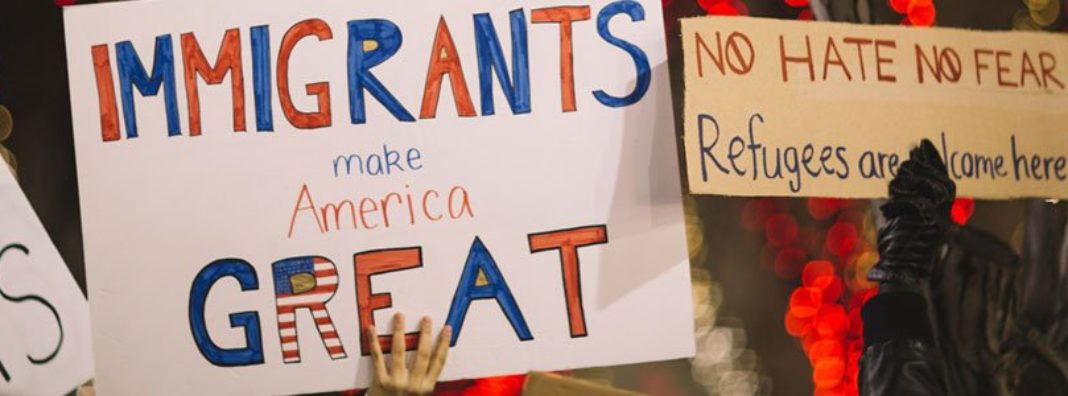
“We have to put Florida children first,” Florida Governor Ron DeSantis told reporters Tuesday. In his press conference, DeSantis announced three separate actions on immigration policy. He ordered restrictions on state agencies working with the federal government in transporting immigrants, appointed a public safety czar, and noted the filing of a lawsuit against the Biden administration. As Florida’s Attorney General Ashley Moody explained the state’s argument, “The Biden administration … is jeopardizing the safety and security of our state and nation, all while costing Florida taxpayers.” Moody continued saying that the Biden administration is “creating a crisis at the southern border like we have never seen.”
Are there real concerns here? Immigration is a contentious political topic, so sorting fact from fiction is not always straightforward. Research on immigration gives us ample cause for skepticism regarding the actual impact immigrants have on their community. As immigration scholar Neeraj Kaushal explains in her book, Blaming Immigrants, “Immigration has become a common scapegoat, and this commonality is taken as evidence of its culpability.” In this sense, Florida’s Biden Border Crisis executive order is not unusual.
Policymakers who want to address the real concerns will need to look deeper into the problems confronting Americans today instead of pointing at immigrants.
Immigrants are no great threat to natives
American history is bursting with examples of previous woes being laid at the feet of immigrants. During the Great Depression, the United States sent a million Mexicans back to Mexico, including some with US citizenship. This was an effort to improve economic prospects for natives that recent research suggests failed. In another study of the Depression era, as wages for low-skill workers rose relative to high-skill worker wages, immigration became easier and more open. Similarly, in a 1986 study, three economists documented that deportations rose in bad economic conditions and fell in good times. The clamor for immigration enforcement in the United States lessened as unemployment fell and manufacturing wages rose.
The concerns about crime and immigration cited by DeSantis are likewise misplaced. It’s difficult to overstate the consensus from research on immigration and crime showing that immigrants are not likely to commit crime. Immigrants commit crime at similar or even lower rates compared to natives of the same age. As two immigration scholars conclude in their review of studies examining immigration and crime, “[P]olicies aimed at reducing the number of immigrants, including unauthorized immigrants, seem unlikely to reduce crime and increase public safety.”
Not only do Florida’s recent actions illustrate the same relationship, more recent research documents it too. Political scientist Sophia J. Wallace analyzed the restrictive immigration policies proposed in various US states beginning in 2010. In times of economic downturn and rising unemployment, she found that Republican legislators proposed increasing immigration restrictions more often than their Democratic counterparts.
Are immigrants an economic burden?
Much of these concerns about immigration’s effects stem from a simplistic economic logic that misses important complexities. If companies are hiring immigrants for cheap, the logic goes, then that makes it harder for natives to compete. Thus, restricting immigration makes easy economic sense. Yet this style of thinking about immigration doesn’t align with the growing body of research on immigration. Far from improving the lots of natives, many immigration restrictions backfired.
One of the clearest examples of failing immigration restrictions is the ending of the Bracero Program in 1964. The Bracero Program was a guest worker program for manual laborers from Mexico. In effect, ending the program meant the removal of half a million migrant workers from the labor force. At the time, those supporting the end of the agreements argued that without access to foreign workers, employers would have to raise wages for the native workers.
Yet studies of the Bracero Program suggest that the change backfired. There appears to have been no increase in wages or employment for natives after removing half a million migrant workers. Instead, employers appear to have replaced workers with machines. This reflects the reality that natives are, usually, better suited for different sets of tasks than immigrants. Because of that, there really isn’t that much competition between natives and immigrants. So even if we restrict immigration, it’s not clear that it will really help natives.
If we assume that immigration restrictions do increase native wages, then businesses face a trade-off. Do they raise wages? Or do they automate? The evidence from the Bracero Program reveals that automating or mechanizing processes to save on labor costs can win out.
Fundamentally, the lesson from the end of the Bracero Program is that immigration restrictions are unlikely to improve the economic lives of low-skill natives. If one of the largest-ever attempts to exclude migrant workers failed to improve wages, there seems to be little evidence that policymakers will significantly improve the economic standing of natives by restricting immigration.
Even where immigration does hurt natives economically, it tends to be in a small and concentrated way. Consider this 2020 study of an influx of 120,000 Puerto Rican refugees to Orlando shortly after Hurricane Maria. The analysis found no evidence that employment levels dropped for anyone. Instead employment grew overall. When the authors looked at wages they found similar results. Wages in both retail and hospitality rose. However, employment in construction grew by 4 percent, but wages dropped by 2.5 percent. The authors attributed this rise to the increased economic activity in the city because of the refugees. Overall, the entire city benefitted. Yet there are also small losses to those who face the heaviest competition against immigrants.
The research is clear: immigration is simply not the root of the problems that natives face in the modern economy.
What can policymakers do?
Rather than focus on restricting immigration, policymakers will get more for their effort by concentrating on policies that improve the income of lower wage workers and by facilitating better economic opportunity to underprivileged communities.
Like other immigration researchers, Neeraj Kaushal’s central point in Blaming Immigrants is that the real problems for many natives are not due to immigration. The real causes are more complicated and bound up in a rapidly changing world. But this type of scapegoating presents a challenging obstacle to policymakers: How do policymakers realize the benefits of an open immigration system when the perceived threat posed by immigrants arises in the voter base? Ultimately, Kaushal argues that the root of native woes are from general labor market conditions—economic stagnation not immigration is to blame. Immigration would be less divisive, argues Kaushal, in environments with increased social mobility and lower income inequality. So what options do policymakers have?
Kaushal argues that policymakers will have to find solutions that directly target the sources of anxiety. As her book concludes, “While the discontent is global and some of the drivers are common, for most countries the solutions must be local.…In countries where productivity stagnation is the cause, possible remedies would have to be different.” According to economist Tyler Cowen, for the United States, the diagnosis is stagnation.
We can get a sense for the most promising places to start by looking at where low-income people spend the most of their incomes already. For example, the Bureau of Labor Statistics data shows that housing made up 40.2 percent of the poorest 20 percent’s spending compared to 29.9 percent of the richest 20 percent. The poor spend more on housing than the wealthiest among us. As economist Eli Dourado points out, changes that reduce the costs of housing will directly improve the economic standing of low income Americans.
Of course, we shouldn’t stop at just making housing cheaper. Policymakers should pursue reforms that reduce the costs of all the most expensive areas for the poorest people. That means concentrating on transportation, healthcare, food costs, and energy.
Together, these five items make up more than four out of every five dollars that the poorest spend (for the richest 20 percent these items represent a bit more than three out of every five dollars). Innovations in all of these areas will better help the poorest much more than restrictive immigration policies.
While blaming immigrants might make for a useful electoral strategy by appealing to the economic insecurities of natives, it doesn’t make for good policy. DeSantis’ executive order might not benefit Floridians to the degree he anticipates. In the long-run, immigration makes everyone better off because of its effects on economic growth and innovation. If we want to get serious about improving the lives of the poorest, then we will make more progress by concentrating on the conditions perpetuating poverty, not on restricting immigration.


